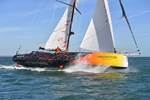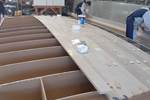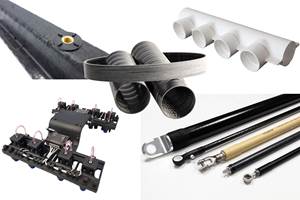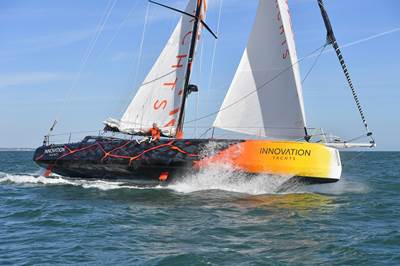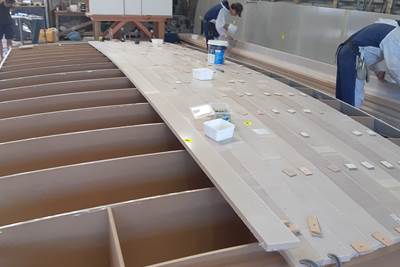Annual boat sales data from the National Marine Manufacturers Association shows continued decrease for 2023 and estimated 2024 retail powerboats. Source | NMMA state of the industry presentation at IBEX 2024
In January 2024, the National Marine Manufacturers Association (NMMA, Washington, D.C., U.S.) published its 2023 statistics. New powerboat retail sales were projected to be down 1-3% to 258,000 units. While most powerboat categories saw unit declines of 5-25%, personal watercraft — small craft for up to three people with entry-level pricing — saw a 20-25% increase, estimated to total 85,000-90,000 new retail units sold in 2023. “With jumps in interest rates and inflation in 2023, we saw more boating consumers being price sensitive and deciding to wait things out before buying their next boat and in the meantime, picking up a personal watercraft,” said Frank Hugelmeyer, NMMA president.
NMMA forecasts that new unit sales in 2024 would be on par with those in 2023, anticipating the effect of continued high interest rates and unsteady consumer confidence in an election year. Meanwhile, it noted that powerboat manufacturers continue to focus on innovative new products with emerging technologies, including solutions to decarbonize recreational boating via sustainable marine fuels, hydrogen (H2), electric and hybrid propulsion systems.
This market summary was confirmed by BoatsGroup.com, a global conglomerate of online boating marketplaces, in its August 2024 market report. Its data showed global sales were down by 9.1% in the first half of 2024 driven primarily by used boat sales (-12.4%) while new boat sales were up by 5.3%. High interest rates and inflation were again cited, explaining why the primary driver for new sales were boats less than 26 feet in length, totaling more than 12,000 in H1 2024.
Also published in August 2024 was a report on top trends in this market, which include sustainability, innovations in materials and technology, customization and unique features, and affordability:
- Sustainability: There is increased interest in electric and hybrid boats for their quieter operation, lower emissions and reduced maintenance. These craft typically are made using composites and also incorporate solar panels and smart technologies for improved operating efficiency.
- Material and technology: Carbon fiber use is increasing due to its light weight while use of bio-based and recyclable composites is also increasing. Meanwhile, smart navigation systems, advanced safety features like collision avoidance and increased integration of autonomous technology and AI are emerging trends, offering features like automated docking and predictive maintenance.
- Customization: Boaters are looking for personalization via external colors and graphics as well as customized technology and performance options. This includes enhanced space and usability according to their preferences.
- Affordability: The market is still very sensitive to price, and this supports the continued preference for outboard motorboats as well as personal watercraft, which continue to show increased sales versus other segments.
Trends in ships
For larger maritime vessels and ships, the most important trend continues to be reducing carbon footprint, according to a September 2024 article by International Shipping News. This includes developments in new fuels, fuel efficiency technologies — such as optimized hull forms and air lubrication systems — as well as zero-emission technologies like H2 and wind propulsion. Indeed, experts project that widespread use of wind propulsion and alternative fuels will be critical to meet the International Marine Organization’s (IMO, London, U.K.) targets. These include:
- End-date for fossil fuels via net-zero greenhouse gas (GHG) emissions by 2050
- Checkpoint of 20% (striving for 30%) reduction by 2030
- Supported by target of 5-10% uptake of near/net-zero GHG emission technologies and fuels by 2030
- Checkpoint of 70% (striving for 80%) reduction by 2040.
Other trends include the digital transformation of shipping and an increase in autonomous vessels — driving an increased need for cybersecurity and data standards — as well as the use of automation, machine learning and cloud-based systems in both production and operations.
The FIBRE4YARDS survey included 39 shipyards from EU countries, led by Spain, France and Portugal (top) and four main classifications of vessels produced (bottom). Source | “Composite materials, technologies and manufacturing: Current scenario of European Union shipyards”
A 2023 report on the use of composites in EU shipyards reiterates these trends and also how they are driving increased interest in using composites. The report discusses a survey conducted as part of the FIBRE4YARDS project that asked shipyards about experience and interest in advanced composite construction technologies, including adaptive molds, automated tape laying/fiber placement, curved pultruded profiles, additive manufacturing (AM), heated stamping, modular and serialized shipbuilding, and digitization of production.
Out of 426 shipyards contacted, 39 responded. These shipyards were classified by the type of boats in production (see graph at right) with most producing several vessel types including 21% that produce either passenger ships + service vessels or special purpose ships + service vessels. As shown below, 77% of the surveyed shipyards use composites either in-house or through subcontractors. The most common materials and processes are mostly expected, however it is surprising to see the high ranking of carbon fiber and epoxy used.
Responses to FIBRE4YARDS survey regarding composites used and which technologies shipyards would be interested in. Source | “Composite materials, technologies and manufacturing: Current scenario of European Union shipyards”
3D printing in boats, plugs for molds
3D printed hulls for an autonomous ferry used in the 2024 Olympics (left) and for Felicity Boats’ new Felicity 1000 (bottom right) by 10XL while Impacd Boats are 3D printed from recycled plastics (top right). Source | 10XL and Impacd Boats
The use of 3D printed composites in boatbuilding and marine applications continues to grow. In March 2024, CEAD Group (Delft, Netherlands) noted several new 3D printing developments in boat manufacturing. One of these was a 3D printed autonomous ferry for the 2024 Olympic Games in Paris. It was commissioned by Holland Shipyards (Hardinxveld-Giessendam, near Rotterdam) and was created by the nearby print service 10XL using a robotic 3D printer. 10XL has also worked with Impacd Boats (Woudsend, Friesland, Netherlands), which is now printing the hulls for its electric-powered sloop boats from recycled materials. Founder Marieke de Boer notes that each Impacd 3D printed boat can be recycled about eight times.
10XL has pioneered large-area AM with recycled plastics since 2016. It has also been involved in other maritime projects, including large boat furniture and stealth underwater unmanned vehicles (UUVs) for navies. After scrutinizing and advancing its technology in 2024, 10XL now touts full layer temperature control, industrial-grade infill and isotropic material performance. In October 2024, it delivered the new Felicity 1000 model of carp fishing boat for Felicity Boats International (Franeker, Netherlands).
Note, even though Impacd Boats and Felicity Boats are using mainly unreinforced recycled plastic, CEAD machines commonly use fiber-reinforced thermoplastic pellets in their extrusion heads and can also use continuous fiber. CEAD wants to make sure 3D printed composites also move forward in marine, and announced in October 2024 that it would open a Maritime Application Center in Delft. This facility will feature a 12-meter-long extrusion-based 3D printer designed for producing boat hulls, along with several other LFAM machines (such as ATLAM and Flexcube). The center aims to foster collaboration between marine industry leaders and CEAD’s experts to develop large 3D printed vessels and marine components, share knowledge and advance in areas such as regulation and certification. First projects are signed, and an industry-focused event is planned for the end of Q1 2025, with the official opening scheduled for Q3 2025.
CEAD’s technology uses thermoplastic composites reinforced with glass, carbon or natural fibers. This approach eliminates the need for molds, reducing production time and labor-intensive processes.
CEAD extrusion heads are also being used for faster, more sustainable boat plug production. Rapid Prototyping (Budapest, Hungary) manufactured molds from CNC-machined polyurethane foam and hand-laid glass fiber-reinforced plastic (GFRP) for years. In 2020, it acquired an E25 robot extruder from CEAD, integrated that into its 4,850 × 2,635 × 1,460-millimeter gantry CNC machine and began using this system to produce molds and prototypes with 30% short glass fiber-reinforced polypropylene (PP). According to owner György Juhász, this cut labor time by up to 50% and also reduced lead times.
The use of 3D printed plugs has resulted in an improved end product, he notes, while requiring fewer layers of fiberglass and paint compared to traditional plugs using foam. It has also optimized workflow, with each plug printed in multiple pieces that can be machined while the next piece is printing. Once all pieces are printed and milled, they are joined with adhesive and small plastic inserts. When the plug is complete, hand layup is used to make a fiberglass/PP mold from the plug, which will be the basis for manufacturing the final yacht hulls. In 2022, Rapid Prototyping tested this production process by manufacturing a plug for a 55-foot boat hull comprising 44 pieces, demonstrating reduced labor and waste. For more details, see “Large-format AM speeds plug production for manufacture of composite boat molds”.
Carbon fiber topsides, bonded repairs for ships
Another continuing trend in boatbuilding/marine applications is the use of carbon fiber for increased light weight, especially in deckhouses and superstructure. For example, Vabo Composites (Emmeloord, Netherlands) produced two lightweight carbon fiber composite deckhouses for a prominent Dutch sailing yacht builder. “By using composite materials, we provide our clients with an unrivaled combination of strength, lightweight construction and durability,” the company explained in a press release.
StrengthBond and DuraBond Offshore projects
Carbon fiber is also the material of choice for large (e.g., 40 square meters) laminated/bonded composite patches to repair corrosion in steel vessels including ships and offshore oil production vessels. “But there is no standardized repair for wide, flat plates that are primary structure for these maritime applications,” explains Stéphane Paboeuf, head of the Composites Materials Section of the classification society Bureau Veritas (Nantes, France). To address this, Bureau Veritas worked with a consortium of industry partners in the StrengthBond Offshore project (2019-2023).
Carbon fiber composite patch repairs were tested in the StrengthBond Offshore project. Source | Bureau Veritas, StrengthBond Offshore
The project developed a robust methodology for the strength analysis of such repairs, including numerical tools to assess and validate designs, surface preparation and manufacturing protocols, and physical testing. The latter included developing a new equivalent interface specimen which enables characterization of the multiple interfaces within the bonded composite patch. By the end of the project, more than 250 specimen tests and 115 numerical simulations had been completed, including fatigue testing on large-size specimens, comprising 50,000 to 5 million cycles.
Repair patch layup where blue and gray plies are carbon fiber, green plies are glass for galvanic isolation and the steel substrate is orange. Long and short scarf angles tested are shown at top right. Source | StrengthBond Offshore
These patches used carbon fiber because “excessive thickness would be required if we used glass fiber,” says Paboeuf, “but we did use some layers of glass fiber between the carbon fiber and the steel to prevent galvanic corrosion.” The patch repairs used epoxy resin without an adhesive and were post-cured at 80°C for a total cycle of 16 hours. Two different manufacturing processes were tested: vacuum-assisted resin infusion and vacuum bagged hand layup. Results showed both had roughly the same strength. However, long scarf joint designs showed a 38% higher repair patch strength versus short scarf designs.
DuraBond Offshore, a follow-on 3-year project, was launched in November 2024, which will involve aging specimens in water and hydrocarbons as well as high and low temperatures and then testing them in static loading and fatigue. Through this testing, says Paboeuf, “we can evaluate the influence of the environment on the strength of the patch in order to tune the safety factor and confirm long-term performance.”
Toray VARTM repairs for ships
Carbon fiber supplier Toray Industries (Tokyo, Japan) has also pursued bonded composite repairs for ships. In September 2024, Toray announced it obtained type approval from the U.S.-based classification society American Bureau of Shipping (ABS, Houston, Texas) for a vacuum-assisted resin transfer molding (VARTM) process for applying carbon fiber-reinforced polymer (CFRP) laminate repairs. This approval enables VARTM to be applied to ABS-certified vessels, reducing the time required for engineering reviews and verification. The repair process applies Toray carbon fiber woven fabric to the surface of a steel structure. The fabric is then covered with a vacuum bag and injected with epoxy resin that is cured, bonding the CFRP to restore strength to the corroded area.
Composites for wind, electric and H2 propulsion
GT Wings will partner with KS Composites to build its AirWing propulsion system for ships. Source | GT Wings
In August 2024, U.K.-based wind propulsion company GT Wings announced a strategic partnership with KS Composites (Melton Mowbray, U.K.) for the production of its AirWing technology. Designed for commercial shipping, AirWing aims to cut fuel consumption and carbon emissions by up to 30%, helping ship owners meet stringent European Union (EU) and IMO environmental standards while achieving substantial fuel savings. The first AirWing unit was scheduled to be installed in Q4 2024 on a 124-meter general cargo vessel operated by Carisbrooke Shipping. In October 2024, GT Wings was awarded a grant as part of the Smart Shipping Acceleration Fund (SSAF) delivered by Innovate UK, focused on developing the technology necessary to decarbonize the U.K. maritime sector.
Composites are used in the construction and foils of Artemis Technologies’ electric hydrofoiling vessels. Source | Artemis Technologies
Composites are also key to lightweight electric boats and in hydrofoils, often used to further augment their performance. In August 2024, Artemis Technologies (Belfast, U.K.) announced the opening of its first U.S. office following significant interest across North America. The company designs, engineers and manufactures 100% electric hydrofoiling vessels powered by its eFoiler system. Artemis watercraft feature composite/metallic foils and a glass and carbon fiber composite construction. “The maritime industry is undergoing a transformative shift toward more sustainable operations,” says David Tyler, co-founder of Artemis Technologies. This includes hundreds of ferry systems that currently operate with inefficient diesel engines along routes through densely populated and often marginalized communities. “Ferry operators are increasingly recognizing that they must adopt electric power to reduce emissions and modernize their fleets,” adds Tyler. “We have the tried, tested and proven solutions to make this transition a commercial success.”
Type 4 CFRP pressure vessels will be used to store H2 fuel on Greenpeace’s new 75-meter vessel. Source | Hexagon Purus Maritime
Meanwhile, Hexagon Purus Maritime (Ålesund, Norway), a wholly owned subsidiary of Hexagon Purus (Oslo, Norway), is developing and supplying Type 4 CFRP pressure vessels to provide H2 storage for a range of zero-emission marine vessels. In September 2024, it announced a contract from Freire Shipyard (Vigo, Spain) to supply tanks for a compressed gas H2 system for Greenpeace’s new 75-meter vessel. Delivery of the system is slated for 2027. Hexagon Purus Maritime notes that making green H2 available for use in the maritime sector is crucial to reducing the world’s GHG emissions. The company has a number of projects in development. Green H2 is expected to supply up to 25% of the world’s energy needs by 2050.
Continued push for sustainability
Sustainability in marine applications goes beyond decarbonizing propulsion and includes the lightweighting offered by composites but also the search for less energy-intensive and carbon-emitting materials and processes. In a September 2024 announcement celebrating 50 years of collaboration, foam and composites supplier Diab (Laholm, Sweden) noted Brødrene AA’s (Hyen, Norway) use of foam-cored, CFRP construction in its fast, energy-efficient ferries. It pointed out that Brødrene AA’s use of composites extends the lifespan of its vessels, minimizing the need for replacements and reducing overall life cycle costs. But Diab also reported making significant strides in reducing the carbon footprint of its materials, achieving a 50% reduction between 2016 and 2023.

This graphic from Beneteau illustrates circularity as the concept applies to the company’s First 44e model made with Elium. Source | Beneteau Group
The entire exterior and inner structures for the Flax27 Daysailer are built with infused flax fiber composites with a bio-based epoxy and recycled PET foam core. Source | Greenboats
A February 2024 CW article discusses a wide range of boatbuilders and programs that are advancing recycling and bio-based materials. It includes demonstrations of recycling using Arkema’s (Colombes, France) Elium thermoplastic resin and efforts by the R&D hub of ExoTechnologies (Douglas, Isle of Man, U.K.) and its subsidiary The Ultimate Boats Co. (Clydebank, Scotland), as well as Innovation Yachts’ (Les Sables d’Olonne/Vairé, France) use of basalt fiber and Greenboats’ (Bremen, Germany) use of flax fiber. Greenboats is also highlighted in technical editor Hannah Mason’s October 2024 article, “Evolving natural fiber technology to meet industry sustainability needs.”
Another company using basalt fiber is BRŪT Yachts (Antwerp, Belgium), offering its 29GT with a boat hull made from 50% recycled material from Basaltex (Wevelgem, Belgium).
Meanwhile, Italian company Northern Light Composites (nlcomp, Monfalcone), owner of the patented recyclable composite material technology rComposite, announced in July 2024 that it received more than €500,000 in funding to accelerate the development and commercialization of solutions, including a new line of boats for the European market. The company reports this responds to the growing demand for eco-friendly solutions and contributes to a more sustainable future for the boating industry.
In November 2024, Sicomin (Châteauneuf les Martigues, France) announced the Skaw (A) foiling cruising yacht, which was built in collaboration with Skaw Sailing (Lorient, France) and composite boatbuilder Shoreteam (Colombelles, France). It is constructed using Sicomin’s high-modulus GreenPoxy resins, including SR InfuGreen 171 for the infusion of larger parts and SR GreenPoxy 170 for hand laminating and bonding the secondary structures. These resins, it explains, enabled Shoreteam to achieve an ultra-lightweight 5,000-kilogram displacement and the high mechanical performance necessary to achieve foiling.
MiniLab is an initiative started in 2023 by Adrien Marchandise, co-founder and CTO of Avel Robotics (Lorient, France) to advance sustainability and reduce the sailing industry’s environmental impact. Avel Robotics is a pioneer in using automated fiber placement (AFP) to manufacture high-performance CFRP foils for IMOCA racing sailboats (see CW’s November 2022 tour article).
MiniLab works with industry and research partners to advance the TRL of sustainability solutions. Source | MiniLab
Marchandise describes MiniLab as an open innovation ecosystem that connects public and private partners around full-scale demonstrator projects to develop and test technologies. “MiniLab has two sides,” he explains. “One is a collaborative platform involving industries, technical centers and universities in the development of sustainable proof of concept prototypes. The other is an in situ testing lab via the n°754 Mini 6.5-meter regatta sailing vessel where partners can validate the robustness of these prototypes in real-world sailing conditions.”
MiniLab timeline, including projects to achieve recyclable composite hydrofoils and a next boat made with 100% sustainable materials. Source | MiniLab
In 2023, Marchandise launched a collaborative project co-funded by MiniLab, Avel Robotics and the technical innovation center Compositic (Ploemeur, France) to benchmark different thermoplastic composite (TPC) materials. The first materials to be demonstrated are carbon fiber-reinforced tapes supplied by Suprem (Montagny-près-Yverdon, Switzerland) and Victrex (Clevelys, U.K.) and thermoplastic foams from Diab. Foils for the Mini 6.5 are being made from these materials and will be tested during the 2025 race season. “I integrated a lot of sensors in these parts to measure the materials in operation,” says Marchandise.
In parallel, MiniLab launched a large project funded by Avel Robotics with the Region Bretagne. “We're going to develop a thermoplastic material with improved compressive strength,” says Marchandise. “Our goal is to start the scale up to industrialize thermoplastic composite foils for larger sailing vessels, and we hope to manufacture the first such foils for IMOCA class racing yachts in 2026.”
Related Content
Composites end markets: Aerospace (2023)
With COVID in the past and passengers flying again, commercial aircraft production is ramping up. The aerocomposites supply chain is busy developing new M&P for an approaching next-generation aircraft program.
Read MoreComposites end markets: Industrial (2024)
The use of composites in industrial applications is increasing, driven by the need for higher performance and longer life, whether its parts for industrial machinery, EOAT components, corrosion-resistant equipment and more.
Read MoreYour must-have composites industry guide for 2025
Welcome to CW’s annual SourceBook, your guide to suppliers of machinery, materials, software and other services for the composites industry.
Read MoreComposites end markets: Sports and recreation (2024)
Light weight and high performance continue to make composites popular in the elite sporting good market. Sustainability in both materials and recycling solutions are a key innovation area.
Read MoreRead Next
European boatbuilders lead quest to build recyclable composite boats
Marine industry constituents are looking to take composite use one step further with the production of tough and recyclable recreational boats. Some are using new infusible thermoplastic resins.
Read MorePrefabricated composite panels, joining system ease catamaran construction
New Zealand-based G&T Marine reduces assembly and construction time with ATL Composites’ composite DuFLEX panels.
Read MoreCFRP breakdown poles designed for lightweight, long-lasting use in marine applications
Shellback Canvas LLC wanted to develop a cost-effective alternative to prepreg poles for its canvas boat awnings. The resulting Blacksticks comprise compression-molded carbon fiber braid and epoxy in a unique process.
Read More

